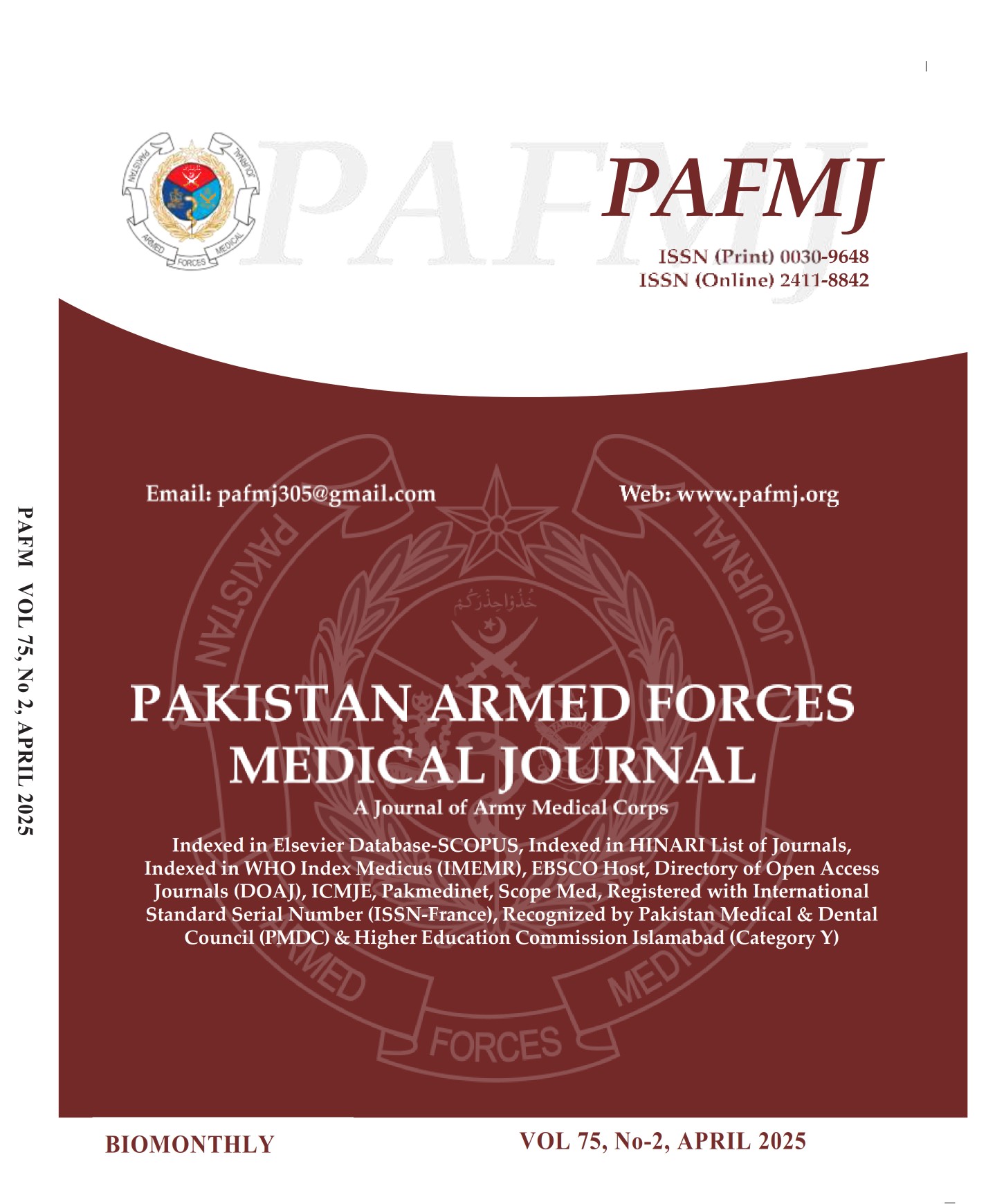Comparison of Diabetic Control in Diabetic Patients, with and without Nutritionist Consultation
DOI:
https://doi.org/10.51253/pafmj.v75i2.10012Keywords:
Diabetes, Diabetic Control, HbA1C%, Nutritionist ConsultationAbstract
Objectives: To compare diabetic control in diabetic patients who undergo nutritionist consultation to those who do not have nutritionist consultation.
Study Design: Quasi-experimental study.
Place and Duration of Study: Pak Emirates Military Hospital, Rawalpindi Pakistan, from Jun to Dec 2022.
Methodology: A total of 42 patients (21 in the Group that had a nutritionist consultation and 21 in the Group that did not have a nutritionist consultation) fulfilling the inclusion criteria were included in the study. At the time of inclusion, baseline HbA1C% was documented for all the patients in both groups. After that, all the patients in Group-A had a nutritionist consultation, while patients in Group-B had dietary counseling from their attending physician. At a three-month follow-up visit, HbA1C% was again checked to assess for diabetic control.
Results: Mean age was 37.52±5.49 years. There were 27(64.30%) male participants and 15(35.70%) female participants. Median BMI was 34.00(37.00–28.00) kg/m2. Median duration of diabetes was 10.00(17.00–7.00) years. Mean baseline HbA1C% was 7.65±0.53%. The mean post-intervention HbA1C% in Group A was 6.37±0.27%, while in Group B, it was 7.10±0.29% (p<0.001).
Conclusion: Nutritionists play a vital role in achieving better and optimal diabetic control in patients who have diabetes.
Downloads
References
IDF-Diabetes Atlas 9th Edition. B-1160 Brussels, Belgium; 2020.
Akhtar S, Nasir JA, Abbas T, Sarwar A. Diabetes in Pakistan: A systematic review and meta-analysis. Pak J Med Sci 2019; 35(4): 1173-1178. https://doi.org/10.12669/pjms.35.4.194
Daryabor G, Atashzar MR, Kabelitz D, Meri S, Kalantar K. The effects of type 2 diabetes mellitus on organ metabolism and the immune system. Front Immunol 2020; 11: 1582.
https://doi.org/10.3389/fimmu.2020.01582
Yamazaki D, Hitomi H, Nishiyama A. Hypertension with diabetes mellitus complications. Hypertens Res 2018; 41(3): 147-156. https://doi.org/10.1038/s41440-017-0008-y
Galicia-Garcia U, Benito-Vicente A, Jebari S, Larrea-Sebal A, Siddiqi H, Uribe KB, et al. Pathophysiology of type 2 diabetes mellitus. Int J Mol Sci 2020; 21(17): 6275.
https://doi.org/10.3390/ijms21176275
Aras M, Tchang BG, Pape J. Obesity and Diabetes. Nurs Clin North Am 2021; 56(4): 527-541.
https://doi.org/10.1016/j.cnur.2021.07.008
Rajaei E, Jalali MT, Shahrabi S, Asnafi AA, Pezeshki SMS. HLAs in autoimmune diseases: Dependable diagnostic biomarkers? Curr Rheumatol Rev 2019; 15(4): 269-276.
https://doi.org/10.2174/1573397115666190115143226
Vlaar EMA, Nierkens V, Nicolaou M, Middelkoop BJC, Busschers WB, Stronks K, et al. Effectiveness of a targeted lifestyle intervention in primary care on diet and physical activity among South Asians at risk for diabetes: 2-year results of a randomised controlled trial in the Netherlands. BMJ Open 2017; 7(6): e012221.
https://doi.org/10.1136/bmjopen-2016-012221
Evert AB, Dennison M, Gardner CD, Garvey WT, Lau KHK, MacLeod J, et al. Nutrition therapy for adults with diabetes or prediabetes: A consensus report. Diabetes Care 2019; 42(5): 731-754. https://doi.org/10.2337/dci19-0014
Siopis G, Colagiuri S, Allman-Farinelli M. Dietitians' experiences and perspectives regarding access to and delivery of dietetic services for people with type 2 diabetes mellitus. Heliyon 2020; 6(2): e03344. https://doi.org/10.1016/j.heliyon.2020.e03344
Matpady P, Mayya GA, Mogan P, Shetty JK, Umakanth S. Effect of dietician consultation on glycaemic control: A cross-sectional survey from the western coast of India. Manipal J Nurs Health Sci 2021; 7(2): 34-39.
American Diabetes Association Professional Practice Committee. Diagnosis and classification of diabetes: standards of care in diabetes-2024. Diabetes Care 2024; 47(Suppl-1): S20-S42.
https://doi.org/10.2337/dc24-S002
American Diabetes Association Professional Practice Committee. Classification and diagnosis of diabetes: Standards of medical care in diabetes-2022. Diabetes Care 2022; 45(Suppl-1): S17-S38.
https://doi.org/10.2337/dc22-S002
American Diabetes Association Professional Practice Committee. 6. Glycemic targets: Standards of medical care in diabetes-2022. Diabetes Care 2022; 45(Suppl-1): S83-S96.
https://doi.org/10.2337/dc22-S006
Kautzky-Willer A, Leutner M, Harreiter J. Sex differences in type 2 diabetes. Diabetologia 2023; 66(6): 1165.
https://doi.org/10.1007/s00125-023-05913-8
Nordström A, Hadrévi J, Olsson T, Franks PW, Nordström P. Higher prevalence of type 2 diabetes in men than in women is associated with differences in visceral fat mass. J Clin Endocrinol Metab 2016; 101(10): 3740-3746.
https://doi.org/10.1210/jc.2016-1915
Karin A, Jon E, Martin A, Lena B, Martin L, Naveed S, et al. Body mass index in adolescence, risk of type 2 diabetes and associated complications: A nationwide cohort study of men. EClinicalMed 2022; 46: 101356.
https://doi.org/10.1016/j.eclinm.2022.101356
Gupta S, Bansal S. Does a rise in BMI cause an increased risk of diabetes?: Evidence from India. PLoS One 2020; 15(4): e0229716.
https://doi.org/10.1371/journal.pone.0229716
Mottalib A, Salsberg V, Mohd-Yusof BN, Mohamed W, Carolan P, Pober DM, et al. Effects of nutrition therapy on HbA1c and cardiovascular disease risk factors in overweight and obese patients with type 2 diabetes. Nutr J 2018; 14: 42.
https://doi.org/10.1186/s12937-018-0351-0
Deshmane AR, Muley SA. Adherence and barriers to medical nutrition therapy and the effect on glycemic control among individuals with type 2 diabetes in India. Curr Res Nutr Food Sci J 2022; 10(3): 1020-1029.
Downloads
Published
Issue
Section
License
Copyright (c) 2025 Adil Khan, Sadaf Nawaz, Namra Nazir, Mehmood Hussain, Rafia Latif

This work is licensed under a Creative Commons Attribution-NonCommercial 4.0 International License.















